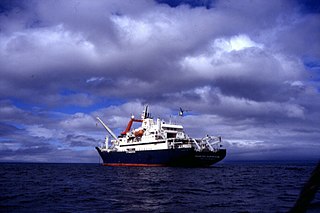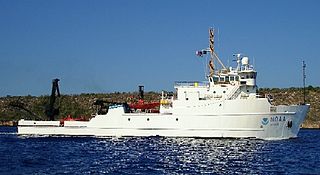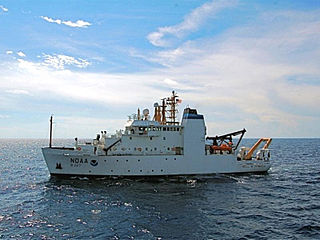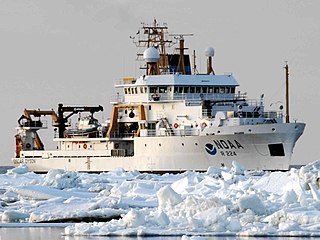
NOAAS Ronald H. Brown is a Thomas G. Thompson-class blue-water research vessel of the U.S. National Oceanic and Atmospheric Administration, she is NOAA's only Global-Class research ship.

The Marion Dufresne II is a research and supply vessel named in honour of the 18th-century French explorer Marc-Joseph Marion du Fresne launched in 1995 and having two main missions: logistic support for the French Austral Islands and oceanographic research.

The bathythermograph, or BT, also known as the Mechanical Bathythermograph, or MBT; is a device that holds a temperature sensor and a transducer to detect changes in water temperature versus depth down to a depth of approximately 285 meters. Lowered by a small winch on the ship into the water, the BT records pressure and temperature changes on a coated glass slide as it is dropped nearly freely through the water. While the instrument is being dropped, the wire is paid out until it reaches a predetermined depth, then a brake is applied and the BT is drawn back to the surface. Because the pressure is a function of depth, temperature measurements can be correlated with the depth at which they are recorded.

RV Atlantis is a Thomas G. Thompson-class oceanographic research ship, owned by the US Navy and operated by the Woods Hole Oceanographic Institution as part of the University-National Oceanographic Laboratory System (UNOLS) fleet. She is the host vessel of DSV Alvin. She is named for the first research vessel operated by WHOI, the sailboat RV Atlantis, for which the Space ShuttleAtlantis is also named.

RV Western Flyer is a twin hulled SWATH research vessel operated by the Monterey Bay Aquarium Research Institute (MBARI). Its relatively stable SWATH design permits expanded operational capability in rough sea states. It is the platform of operations for the ROV Doc Ricketts. The vessel carries 10 crew, 5 ROV pilots, and 11 scientists, for a total complement of 26. Cruises generally center around the central California coast and Monterey Bay, although excursions further afield to Hawaii, the Pacific Northwest, and the Gulf of California have taken place in recent years.

R/V Thomas G. Thompson (AGOR-23), an oceanographic research vessel and lead ship of her class, is owned by the United States Office of Naval Research and operated under a bareboat charterparty agreement by the University of Washington as part of the University-National Oceanographic Laboratory System (UNOLS) fleet.

USNS Adventurous (T-AGOS-13) was a Stalwart-class modified tactical auxiliary general ocean surveillance ship of the United States Navy in service from 1988 to 1992. She was in non-commissioned service in the Military Sealift Command from 1988 to 1992, operating during the final years of the Cold War. She was transferred to the National Oceanic and Atmospheric Administration (NOAA) in 1992 and in 2003 was commissioned into service with NOAA as the fisheries research ship NOAAS Oscar Elton Sette.

USNS Relentless (T-AGOS-18) was a Stalwart-class modified tactical auxiliary general ocean surveillance ship in service in the United States Navy from 1990 to 1993. Since 1998, she has been in commission in the National Oceanic and Atmospheric Administration (NOAA) fleet as the fisheries research ship NOAAS Gordon Gunter.

The NOAA Ship Nancy Foster is a National Oceanic and Atmospheric Administration research vessel. The ship is named for Dr. Nancy Foster, who was the director of the National Marine Fisheries Service’s Office of Protected Resources from 1986 until 1993, and the director of the National Ocean Service from 1997 until her death in 2000.

The Institute of Marine Sciences (IMS) is a Turkish facility that focuses on marine science-related education and research. IMS was founded in 1975 on the Erdemli Campus at METU in Erdemli / Mersin. Institute's campus at Erdemli, houses laboratories, office buildings, computing and remote sensing facilities, a library, an atmospheric tower, and other services. Housing for staff and students, and harbor facility are also located on the campus.

Thomas Washington (T-AGOR-10) was a Robert D. Conrad-class oceanographic research ship delivered to the U.S. Navy in 1965. The ship was owned by the Navy but assigned to the Scripps Institute of Oceanography, University of California, La Jolla, California and operated as R/VThomas Washington from delivery to inactivation.

For information about the CTD-rosette equipment package as a whole, see: Rosette sampler

NOAAS Bell M. Shimada is an American fisheries research ship in commission with the National Oceanic and Atmospheric Administration (NOAA) since 2010. She operates along the United States West Coast.

NOAAS Reuben Lasker is a National Oceanic and Atmospheric Administration (NOAA) fishery research vessel. The ship's namesake, Reuben Lasker, was a fisheries biologist who served with the Southwest Fisheries Center, National Marine Fisheries Service, and taught at the Scripps Institution of Oceanography. This class of NOAA ships is very similar to, and based in part upon, the Neil Armstrong-class Oceanographic Research (AGOR) ships owned by the Office of Naval Research and operated by various US Universities.

For information about the conductivity-temperature-depth (CTD) instrument, see: CTD (instrument).

R/V Ocean Starr is an American research vessel. She was in the United States Fish and Wildlife Service's Bureau of Commercial Fisheries fleet from 1966 to 1970 as US FWS David Starr Jordan. The ship later served under the National Oceanic and Atmospheric Administration (NOAA) from 1970 to 2010.

NOAAS Oscar Dyson is an American fisheries and oceanographic research vessel in commission in the National Oceanic and Atmospheric Administration (NOAA) fleet since 2005.

NOAAS Pisces is an American fisheries and oceanographic research vessel in commission in the National Oceanic and Atmospheric Administration (NOAA) fleet since 2009.
RSVNuyina is an icebreaking research and supply vessel intended to support Australian scientific activities and research bases in Antarctica. Capable of deploying a wide range of vehicles, including helicopters, landing barges and amphibious trucks to support the resupply operation, the new ship provides a modern platform for marine science research in both sea ice and open water with a large moon pool for launching and retrieving sampling equipment and remotely operated vehicles.

JS Shōnan (AGS-5106) is the only ship of her type of oceanographic research ship for the Japan Maritime Self-Defense Force.






















